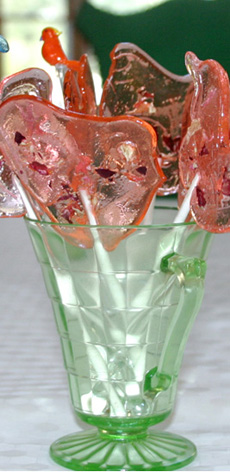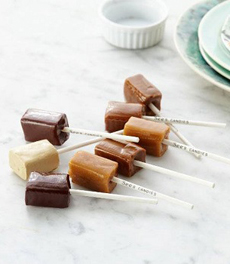Homemade Lollipops For National Lollipop Day
 [1] Your homemade lollipops can be free-form with inclusions, like the bits of flower petals above (photo © Sacred Sweets). |
Looking for a fun activity? How about making lollipops? Today is National Lollipop Day July 20th, and Exploratorium has a recipe that lets you be a lollipop chef. You can make favorite flavors that aren’t often found in commercial products. We’ve got anise, banana, hazelnut, mint, and rum extracts that are just waiting to flavor lollys (the original spelling). The other ingredients include sugar, corn syrup, water, cream of tartar, and liquid food coloring. You can mix up standard or unusual colors with food coloring; but the idea that really appeals to us comes from Sacred Sweets in Greenport, New York. They turn lollipops into edible art with: Lollipop sophistication has come a long way since prehistoric man licked honey off the stick he used to scrape it from the beehive. The ancient Arabs, Chinese, and Egyptians made fruit and nut confections candied in honey, which may also have been eaten from sticks, owing to the stickiness of the confection. But what we think of as a lollipop may date to Europe in the Middle Ages, when sugar was boiled and formed onto sticks as treats for the wealthy—the only people who could afford sugar. |
|
|
By the 17th century, sugar was plentiful and affordable. In England, boiled sugar (hard candy) treats were popular. The word “lollipop” (originally spelled lollypop) first appears in print in 1784, roughly coinciding with the beginning of the Industrial Revolution. Beginning in the later part of the 18th century, industry, including confectionery, became mechanized. Horehound drops, lemon drops, peppermints, and wintergreen lozenges became everyday candies. |
||
|
While we don’t know the inventor of the modern lollipop, the first automated lollipop machine was invented in Racine, Wisconsin in 1908. The Racine Confectionery Machine Company’s machine put hard candy discs on the end of sticks, producing 2400 lollipops per hour, 57,000 per day. Today’s machines can produce 3 million lollipops daily. Far beyond the specialty Blow Pops, Tootsie Pops, Sugar Daddys of childhood, today’s lollipops come in all shapes and sizes, from hand-crafted works of sugar art to caffeinated Java Pops and bacon lollipops. And handcrafted lollipops still exist, made by companies like Hammond’s Candies, where artisans coil ropes of boiled hard candy into colorful jumbo lollipops. See’s Candies chooses the original spelling for its “lollypops,” but perhaps that’s to differentiate the creamy candy-on-a-stick from conventional lollys. |
 [2] See’s creamy “lollypops,” made with butter and cream (photo © See’s Candies). |
|
|
See’s are made with butter and heavy cream, in a square shape (see photo at right). Available in butterscotch, café latté, chocolate, chocolate orange, root beer, and vanilla (plus holiday flavors), they have the consistency of butterscotch and are certified kosher by KSA. And they’re addictive! Treat yourself to some at Sees.com. CHECK OUT WHAT’S HAPPENING ON OUR HOME PAGE, THENIBBLE.COM.
|
||


